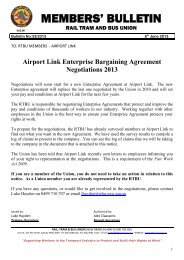Safety Matters - Rail, Tram and Bus Union of NSW
Safety Matters - Rail, Tram and Bus Union of NSW
Safety Matters - Rail, Tram and Bus Union of NSW
Create successful ePaper yourself
Turn your PDF publications into a flip-book with our unique Google optimized e-Paper software.
Undertaking OHS Risk Management<br />
To be most effective risk management should become part <strong>of</strong> an organisation’s<br />
culture. It should be integrated into an organisation’s philosophy, practices <strong>and</strong><br />
business plans so that everyone in the organisation is involved rather than being<br />
viewed or practiced as a separate program.<br />
OHS risk management involves the process <strong>of</strong> hazard identification <strong>and</strong> risk<br />
assessment <strong>and</strong> control. Information is gathered, decisions made <strong>and</strong> actions<br />
taken to rectify OHS issues. It is performance based, allowing employers the<br />
flexibility <strong>and</strong> capacity to develop more effective solutions to workplace health<br />
<strong>and</strong> safety issues.<br />
Chapter 2 <strong>of</strong> the OHS Regulation 2001 imposes obligations on all<br />
employers to implement risk management processes in all workplaces.<br />
Employers must take reasonable care to identify any foreseeable hazard<br />
that has the potential to harm the health <strong>and</strong> safety <strong>of</strong> employees or any<br />
other persons in the workplace.<br />
The Regulation defines a hazard as ‘anything (including work practices or<br />
procedures) that has the potential to harm the health or safety <strong>of</strong> a person’.<br />
Hazard prevention <strong>of</strong>fers the best opportunity for reducing workplace<br />
injury or illness.<br />
Hazards arise from the workplace environment, use <strong>of</strong> plant <strong>and</strong> substances,<br />
poor work design, inappropriate systems <strong>and</strong> procedures <strong>and</strong> human behaviour.<br />
In order to control hazards we need to be aware <strong>of</strong> their existence. Hazards can<br />
be classified into five broad areas:<br />
• physical eg. noise, radiation, light, vibration<br />
• chemical eg. poisons, dusts<br />
• biological eg. viruses, plants, parasites<br />
• mechanical/electrical eg. slips, trips <strong>and</strong> falls, tools, electrical equipment<br />
• psychological eg. stress, boring work, violence or aggression.<br />
Hazard management plans can be developed after hazards have been classified,<br />
eg. a chemical hazard management plan.<br />
The OHS Act (Section 15(a) <strong>and</strong> Section 18) <strong>and</strong> Regulation (Chapters<br />
2 <strong>and</strong> 3) clearly identify a key role for OHS Committees <strong>and</strong> OHS<br />
Representatives in workplace risk assessments <strong>and</strong> ‘to investigate any<br />
matter that may be a risk to health <strong>and</strong> safety at the place <strong>of</strong> work’.<br />
<strong>Safety</strong> <strong>Matters</strong> A Guide for Workplace OHS Representatives<br />
SECTION TWO<br />
RAIL<br />
TRAM AND BUS<br />
39<br />
Monitoring OHS Programs <strong>and</strong> Procedures<br />
U N<br />
I O N

















